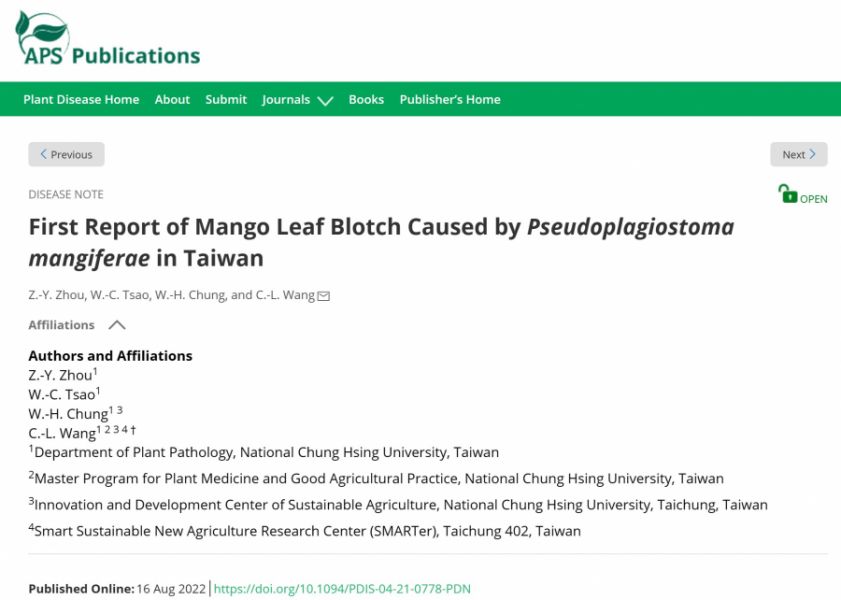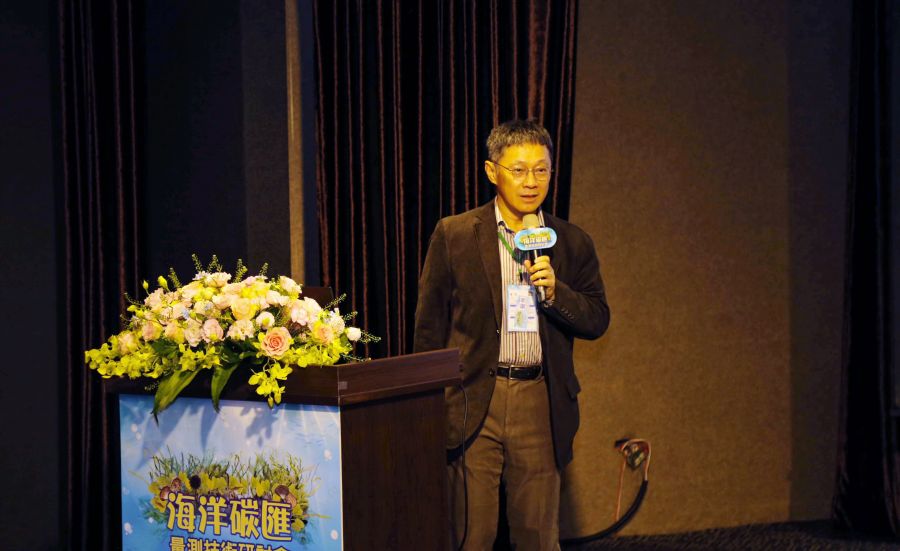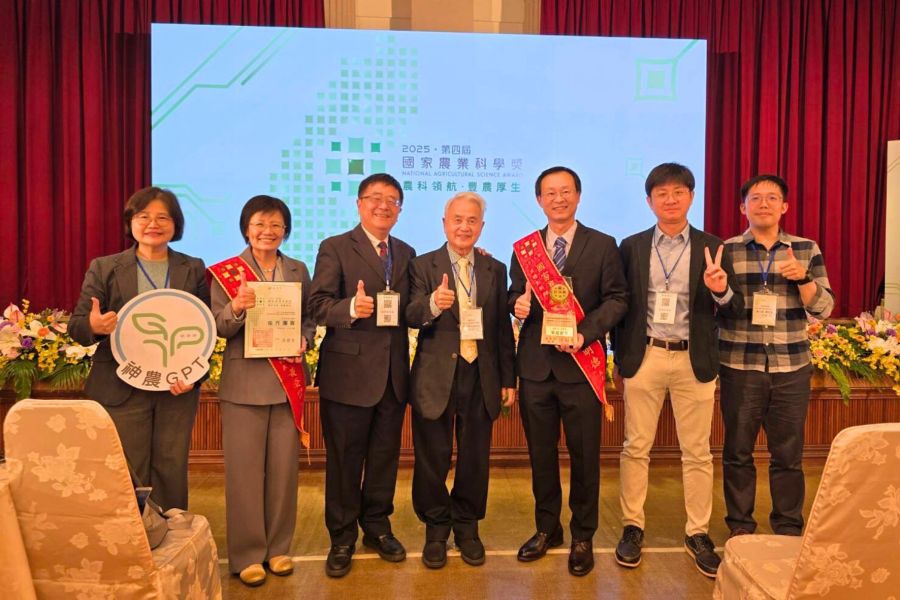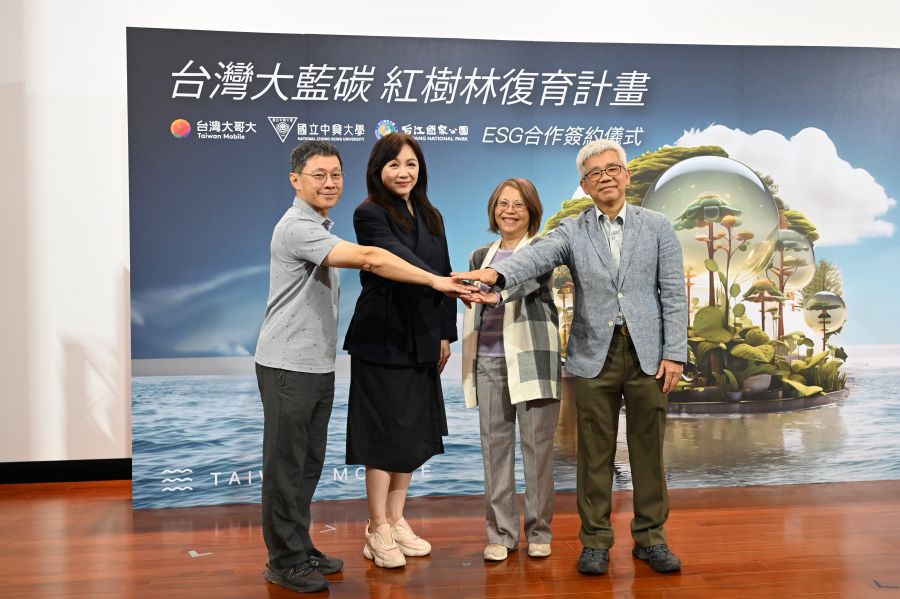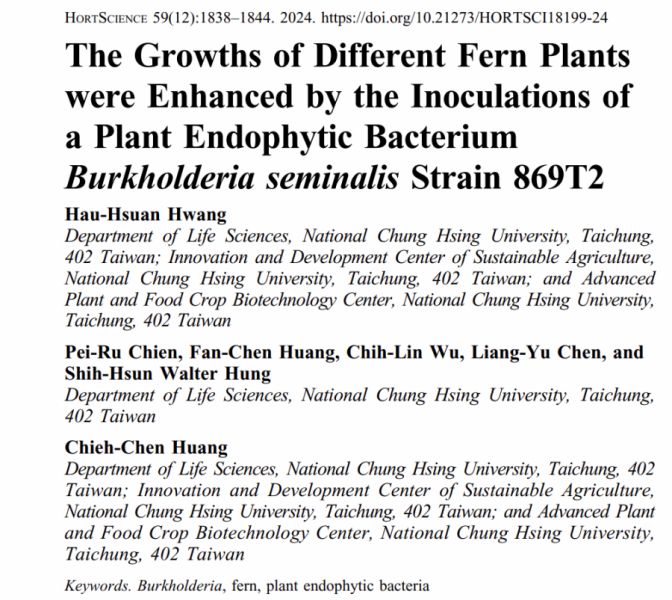新穎材料農業:農業新穎材料在植物保健開發、應用與機理【植物病理學系/王智立副教授/優聘教師】
| 論文篇名 | 英文:First report of mango leaf blotch caused by Pseudoplagiostoma mangiferae in Taiwan. 中文:由Pseudoplagiostoma mangiferae引起之芒果葉斑病於台灣的首次報導 |
| 期刊名稱 | PLANT DISEASE |
| 發表年份,卷數,起迄頁數 | 2022, 106, 2752 |
| 作者 | Zhou, Zi-You; Tsao, Wei-Chin; Chung, Wen-Hsin(鍾文鑫); Wang, Chih-Li(王智立)* |
| DOI | 10.1094/PDIS-04-21-0778-PDN |
| 中文摘要 | 芒果為台灣南部重要的經濟作物。在 2019 年 2 月於高雄美濃 (N22°54'43.7" E120°32'59.3") 所採集的葉片樣本上發現了有別於炭疽病的不同病斑,病徵為圓形至不規則形,病斑外圍深褐色,中央淺褐色且容易破碎的特徵。相似的病斑也於同年 6 月,台南玉井 (N23°07'31.3"E120°27'18.2") 的樣本上觀察到。本篇共調查了 3 個品種 (愛文、玉文 6 號及土芒果) 共60 株植株的罹病率,各品種的罹病率依序為 25%、37%、73%。來自兩個採集地點的葉片樣本經由表面消毒後,進行組織分離,並挑選其中 7 株分離株作為本篇研究的供試菌株。在形態上,菌株培養 7 天後可觀察到柄子殼產生,產孢細胞為透明、短瓶狀;分生孢子厚壁、透明且無隔膜,基部具有平坦的臍,大小為 20-24 × 11-16 μm,近圓形 (subcircular) 至橢圓形 (ellipsoid),並可觀察到孢子內具有 1-2 個明顯的油滴。根據在 7 株分離株上述觀察到的形態,鑑定其屬於Pseudoplagiostoma。病原性測試的部分,於品種愛文之 10 片為成熟葉片進行接種,接種試驗於溫室環境下溫度 25℃ 進行,每片葉子有 6 個接種點,每個接種點於葉背接種 10 μl 106 conidia/ml 濃度之分離株 TMg 8-1.1 孢子懸浮液,並以無菌水接種作為實驗之對照。接種的枝條將以塑膠袋套袋兩天後拆袋。約 70% 的接種點 (n = 60) 在接種後第七天可觀察到與田間相似的病徵,對照組則沒有。其餘 6 株分離株的病原測試則使用切離葉,以點接種的形式測試其病原性,並同樣於 25℃、12 h 日照/黑暗的條件下進行,相似的病徵同樣可於 7 天後觀察到。並且,從接種葉上再分離的菌株和原先自田間病葉上所分離的菌株具有相同的形態特徵。以引子對 ITS4/V9G, T1/Bt-2b, 及 LSU1Fd/LR5 針對7 株分離株的轉錄區間內序列 (Internal transcribed spacer, ITS)、β – 微管蛋白 (TUB2) 以及 28S 的大次單元 (LSU) 序列 (ITS accession nos.: MN818659 to MN818665; TUB2 accession nos.: MW415921 to MW415927; LSU accession nos.: MN876849 to MN876855) 進行增幅並作為親緣演化鑑定的依據。分離株和 Pseudoplagiostoma mangiferae Dayarathne, Phookamsak & K. D. Hyde KUMCC 18-0179 (the ex-type strain) 的 ITS 基因 (MK084824)、TUB2 基因 (MK084823)、LSU gene (MK084825) 之序列相似性分別為 95.8、99 至 100、和 99.8%。以上述提及的序列進行多基因親緣演化的分析,7 株分離株皆和 P. mangiferae KUMCC 18-0179 被劃分在同一支序群,bootstrap 值為 100%。依據病原性和形態特徵,病原菌被鑑定為 P. mangiferae - 一株首次在中國雲南省被報導和芒果葉斑病相關的新種病原菌。這一新出現的病害可能會成為未來在芒果上的潛在流行病。 |
| 英文摘要 | Mango (Mangifera indica L.) is an economically important tropical fruit in southern Taiwan. In February 2019, new leaf blotches distinct from anthracnose lesions were noticed on mango leaves in Meinong, Kaohsiung (N22°54'43.7" E120°32'59.3"). Symptoms were circular to irregular lesions with easily torn centers and were cream to light brown with dark brown margin on both leaf surfaces. Similar symptoms were observed on mango leaves in Yujing, Tainan (N23°07'31.3" E120°27'18.2") in July of the same year. We surveyed the disease incidence on 60 mango trees consisting of three cultivars, ‘Irwin’, ‘Yu-win No.6’ and a native cultivar in a commercial farm by randomly examining five shoots of each tree. The disease incidences of ‘Irwin’, the native cultivar and ‘Yu-win No.6’ were 25%, 37% and 73%, respectively. Diseased tissues from the two locations were surface sterilized and incubated on potato dextrose agar (PDA) for pathogen isolation. Seven isolates (Mgk3, TMg2-2.2, TMg3-1.2, TMg3-2.1, TMg4-1, TMg6-3, and TMg8-1.1) from different locations and cultivars were selected for further study. Pycnidia were produced on 7-day-old PDA cultures. Conidiogenous cells were hyaline and short cylindrical phialides. Conidia were hyaline, aseptate, thick-walled, 20-24 × 11-16 μm, and subcircular to ellipsoid with 1-2 large oil droplets and a markedly flat protruding hilum at the base. These morphological features presenting in the seven isolates were identified as a member of Pseudoplagiostoma. Pathogenicity assays were conducted by the point inoculation method on 10 intact young leaves growing on ‘Irwin’ mango plants in a greenhouse at 20-25℃. Each leaf was inoculated at six points on the abaxial surface with point inoculation. Each point was inoculated with a 10 μl conidial suspension (106 conidia/ml) of isolate TMg 8-1.1. Sterilized water was used as control. Shoots with inoculated leaves were covered with translucent plastic bags for 2 days. At 7 days post-inoculation (dpi), 70% of conidia inoculated points (n = 60) displayed symptoms resembling the field symptoms, but sterilized water inoculated points (n = 60) did not. The six other isolates were inoculated on detached leaves by the point inoculation method. All inoculated leaves were maintained in humid containers at 25℃ with 12 h light/dark regime, and displayed similar lesions at 7 dpi. Fungi re-isolated from the symptomatic leaves showed the same morphological characteristics observed in the Pseudoplagiostoma originally isolated from diseased tissues. Internal transcribed spacer (ITS), TUB2 and LSU gene sequences of the seven isolates (ITS accession nos.: MN818659 to MN818665; TUB2 accession nos.: MW415921 to MW415927; LSU accession nos.: MN876849 to MN876855) were amplified with primer sets ITS4/V9G, T1/Bt-2b and LSU1Fd/LR5, respectively, and used for molecular identification. The seven isolate were 95.8%, 99-100% and 99.8% identical to Pseudoplagiostoma mangiferae Dayarathne, Phookamsak & K. D. Hyde KUMCC 18-0179 (the ex-type strain) for the ITS gene (MK084824), TUB2 gene (MK084823) and LSU gene (MK084825), respectively. Phylogenetic analysis based on concatenated sequences of ITS and LSU genes was performed by the Maximum Likelihood method. All seven isolates were clustered in a well-supported clade with P. mangiferae KUMCC 18-0179 with 100% bootstrap value. Based on the pathogenicity and morphological characteristics, the pathogen was identified as P. mangiferae which was reported as a new species associated with mango leaf blight in Yunnan, China. The newly emerging leaf blotch may become a prevalent disease of mango in future. |
| 發表成果與本中心研究主題相關性 | 研究成果說明芒果葉斑病為芒果的新興病害,目前已在台南主要芒果產區發生,且可於不同品種上感染,具有潛在流行的潛力。由於其病徵與炭疽病相似,易被農友誤判而影響防治效果,未來進行芒果田間的病害管理須加已納入防治考慮,以永續發展芒果產業。 |

